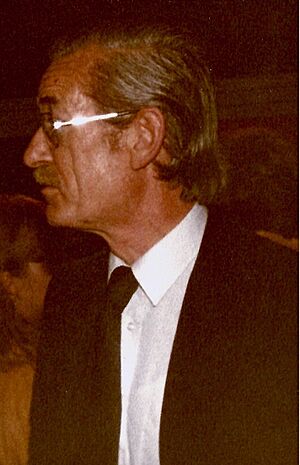Bob de Moor facts for kids
Quick facts for kids Bob de Moor |
|
|---|---|
 |
|
| Born | Robert Frans Marie De Moor 20 December 1925 Antwerp, Belgium |
| Died | 26 August 1992 (aged 66) Brussels, Belgium |
| Nationality | Belgian |
| Area(s) | artist, writer |
|
Notable works
|
Cori, de Scheepsjongen, The Adventures of Tintin Barelli Johan et Stephan |
| Awards | full list |
Robert Frans Marie De Moor (born December 20, 1925 – died August 26, 1992) was a famous Belgian comics creator. Most people know him by his pen name, Bob de Moor. He was known for his clear and precise drawing style, called "Ligne claire". Bob de Moor created many of his own comic series. He also worked closely with the famous artist Hergé on the popular The Adventures of Tintin comics. After another artist, Edgar P. Jacobs, passed away, Bob de Moor even finished one of his Blake and Mortimer stories.
About Bob de Moor
Bob de Moor started drawing when he was very young, around three or four years old. He grew up in a port city, which made him love drawing sailing ships. This love for ships later inspired his own comic series, Cori, de Scheepsjongen.
After studying at the Antwerp Academy of Fine Arts, Bob de Moor began his career at Afim animation studios. His first comic book was written in 1944 for a newspaper called "De Kleine Zondagsvriend".
Working with Hergé
In March 1951, Bob de Moor began working with Hergé on the Tintin comics. His first project was Destination Moon. He helped a lot with the Tintin albums and other Tintin-related projects. This included drawing sketches, backgrounds, and planning the layout of the pages. He even worked on animated Tintin films.
His co-worker, Jacques Martin, once said that Bob de Moor was amazing at drawing in other artists' styles. This meant he could draw just like Hergé, making his work fit perfectly into the Tintin comics. Because of this skill, he was sometimes asked to finish comics that other artists had started.
Bob de Moor also drew the album cover for "A World of Machines" (1982) by the Belgian band The Machines. His son, Johan de Moor, is also a cartoonist. Johan finished his father's last comic album, the fifth in the Cori le Moussaillon series, after Bob de Moor passed away.
Bob de Moor and Tintin's Adventures
Bob de Moor worked at Studio Hergé from April 1951 until the end of 1986. Hergé thought he was the perfect assistant because Bob de Moor could draw the Tintin characters just as well, or even better, than Hergé himself. Here are some of Bob de Moor's most important contributions to Tintin and Milou:
- The Black Island: Bob de Moor completely redrew and updated the 7th Tintin adventure, "The Black Island" (1965). To make sure the drawings were accurate, Hergé sent de Moor to England and Scotland in 1962 to find and draw the real places. Bob de Moor also drew the cover for this book.
- A Fake Tintin Page: In the summer of 1965, while Hergé was traveling, a reporter asked De Moor and Jacques Martin if a new Tintin adventure was being made. Without Hergé knowing, they created a fake page that looked like it was from an unfinished Tintin book. The magazine printed the page. Hergé was upset at first, but he later bought the drawing.
- Tintin and the Lake of Sharks: In 1972, Bob de Moor drew and colored the 47-page comic book version of the film "Tintin and the Lake of Sharks". The story was written by Michel Greg.
- Tintin and the Picaros: One of Bob de Moor's most important works was the drawings for the 1976 album "Tintin and the Picaros". Even though Hergé said he drew the complete album himself, most of the drawings were probably done by Bob de Moor.
See also
 In Spanish: Bob de Moor para niños
In Spanish: Bob de Moor para niños

